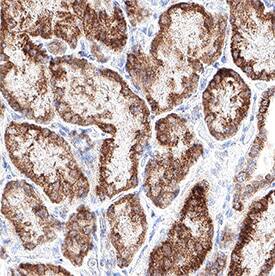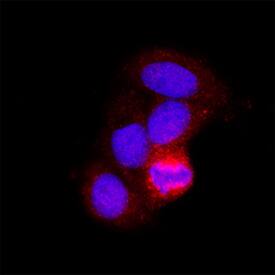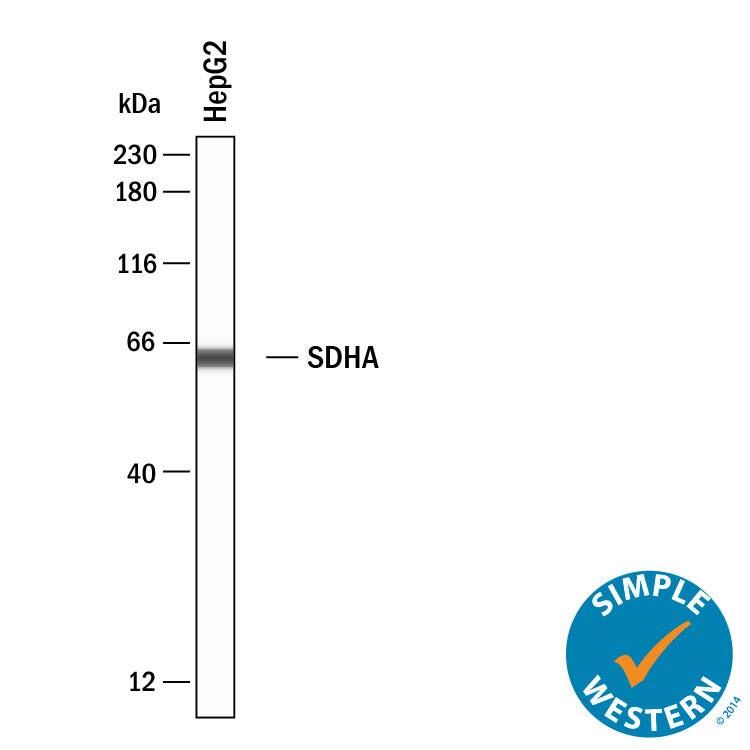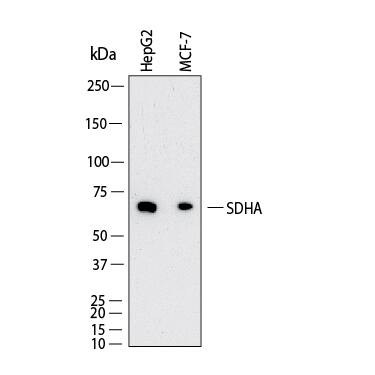Human SDHA Antibody
R&D Systems, part of Bio-Techne | Catalog # MAB11586

Key Product Details
Species Reactivity
Human
Applications
Immunocytochemistry, Immunohistochemistry, Simple Western, Western Blot
Label
Unconjugated
Antibody Source
Monoclonal Mouse IgG2B Clone # 1084056
Product Specifications
Immunogen
Synthetic Peptide
Accession # P31040
Accession # P31040
Specificity
Detects a synthetic peptide corresponding to residues near amino acid 610 of human SDHA protein by Direct ELISA.
Clonality
Monoclonal
Host
Mouse
Isotype
IgG2B
Scientific Data Images for Human SDHA Antibody
Detection of Human SDHA by Western Blot.
Western Blot shows lysates of HepG2 human hepatocellular carcinoma cell line and MCF-7 human breast cancer cell line. PVDF membrane was probed with 1 µg/ml of Mouse Anti-Human SDHA Monoclonal Antibody (Catalog # MAB11586) followed by HRP-conjugated Anti-Mouse IgG Secondary Antibody (Catalog # HAF018). A specific band was detected for SDHA at approximately 70 kDa (as indicated). This experiment was conducted under reducing conditions and using Western Blot Buffer Group 1.Detection of SDHA in Human Kidney.
SDHA was detected in immersion fixed paraffin-embedded sections of human kidney using Mouse Anti-Human SDHA Monoclonal Antibody (Catalog # MAB11586) at 5 µg/ml for 1 hour at room temperature followed by incubation with the Anti-Mouse IgG VisUCyte™ HRP Polymer Antibody (Catalog # VC001). Before incubation with the primary antibody, tissue was subjected to heat-induced epitope retrieval using VisUCyte Antigen Retrieval Reagent-Basic (Catalog # VCTS021). Tissue was stained using DAB (brown) and counterstained with hematoxylin (blue). Specific staining was localized to the cytoplasm. View our protocol for IHC Staining with VisUCyte HRP Polymer Detection Reagents.Detection of SDHA in MCF-7 Human Cell Line.
SDHA was detected in immersion fixed MCF-7 human breast cancer cell line using Mouse Anti-Human SDHA Monoclonal Antibody (Catalog # MAB11586) at 8 µg/ml for 3 hours at room temperature. Cells were stained using the NorthernLights™ 557-conjugated Anti-Mouse IgG Secondary Antibody (red; Catalog # NL007) and counterstained with DAPI (blue). Specific staining was localized to the cytoplasm. View our protocol for Fluorescent ICC Staining of Cells on Coverslips.Applications for Human SDHA Antibody
Application
Recommended Usage
Immunocytochemistry
3-25 µg/mL
Sample: Immersion fixed MCF-7 human breast cancer cell line
Sample: Immersion fixed MCF-7 human breast cancer cell line
Immunohistochemistry
3-25 µg/mL
Sample: Immersion fixed paraffin-embedded sections of human kidney
Sample: Immersion fixed paraffin-embedded sections of human kidney
Simple Western
20 µg/mL
Sample: HepG2 human hepatocellular carcinoma cell line
Sample: HepG2 human hepatocellular carcinoma cell line
Western Blot
1 µg/mL
Sample: HepG2 human hepatocellular carcinoma cell line and MCF-7 human breast cancer cell line
Sample: HepG2 human hepatocellular carcinoma cell line and MCF-7 human breast cancer cell line
Formulation, Preparation, and Storage
Purification
Protein A or G purified from hybridoma culture supernatant
Reconstitution
Reconstitute lyophilized material at 0.2 mg/ml in sterile PBS. For liquid material, refer to CoA for concentration.
Formulation
Lyophilized from a 0.2 μm filtered solution in PBS with Trehalose.
Shipping
Lyophilized product is shipped at ambient temperature. Liquid small pack size (-SP) is shipped with polar packs. Upon receipt, store immediately at the temperature recommended below.
Stability & Storage
Use a manual defrost freezer and avoid repeated freeze-thaw cycles.
- 12 months from date of receipt, -20 to -70 °C as supplied.
- 1 month, 2 to 8 °C under sterile conditions after reconstitution.
- 6 months, -20 to -70 °C under sterile conditions after reconstitution.
Background: SDHA
References
- Horsefield R, Yankovskaya V, Sexton G, Whittingham W, Shiomi K, Omura S, Byrne B, Cecchini G, Iwata S. Structural and computational analysis of the quinone-binding site of complex II (succinate-ubiquinone oxidoreductase): a mechanism of electron transfer and proton conduction during ubiquinone reduction. J Biol Chem. 2006 Mar 17;281(11):7309-16. doi: 10.1074/jbc.M508173200. Epub 2005 Dec 27. PMID: 16407191.
- Schipani A, Nannini M, Astolfi A, Pantaleo MA. SDHA Germline Mutations in SDH-Deficient GISTs: A Current Update. Genes (Basel). 2023 Mar 4;14(3):646. doi: 10.3390/genes14030646. PMID: 36980917; PMCID: PMC10048394.
- Dubard Gault M, Mandelker D, DeLair D, Stewart CR, Kemel Y, Sheehan MR, Siegel B, Kennedy J, Marcell V, Arnold A, Al-Ahmadie H, Modak S, Robson M, Shukla N, Roberts S, Vijai J, Topka S, Kentsis A, Cadoo K, Carlo M, Latham Schwark A, Reznik E, Dinatale R, Hechtman J, Borras Flores E, Jairam S, Yang C, Li Y, Bayraktar EC, Ceyhan-Birsoy O, Zhang L, Kohlman W, Schiffman J, Stadler Z, Birsoy K, Kung A, Offit K, Walsh MF. Germline SDHA mutations in children and adults with cancer. Cold Spring Harb Mol Case Stud. 2018 Aug 1;4(4):a002584. doi: 10.1101/mcs.a002584. PMID: 30068732; PMCID: PMC6071569.
Long Name
SDHA
Alternate Names
CMD1GG, MC2DN1, NDAXOA, PGL5, PPGL5, SDH1, SDH2, SDHF
Gene Symbol
P31040
UniProt
Additional SDHA Products
Product Documents for Human SDHA Antibody
Product Specific Notices for Human SDHA Antibody
For research use only
